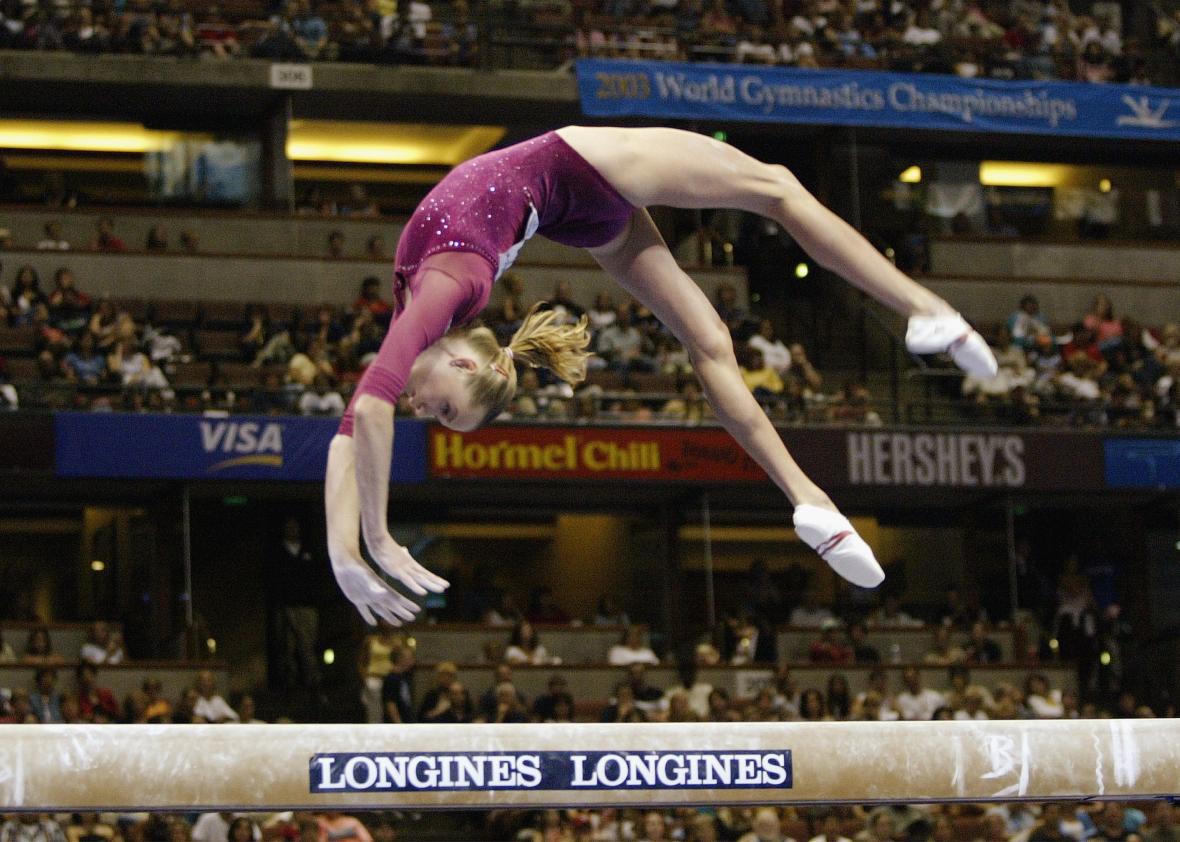I miss Svetlana Khorkina. I miss her shade-throwing and dagger glares and how she was like a foot taller than everyone she was competing against. I miss her screaming with the fury of a silent-screen siren at officials during the 2000 Sydney Games when they set the vault two inches too low. And I miss that she could somehow manage to do the following when she mounted the balance beam at the 1996 Atlanta Games.
Look at that. It’s like seeing a giraffe perfectly execute the 32 fouettés in Swan Lake. And that’s how her beam routine starts. She still has to do all this other stuff!
Alas, if my beloved Khorkina were competing today, she would likely just hoist herself onto the beam—maybe into a split, but maybe not!—just as Simone Biles and Gabby Douglas and Madison Kocian are accustomed to doing. Or maybe she would hop primly off the springboard onto the beam, Aly Raisman–style.
She definitely would not use her head and neck to roll onto the beam and then grip it with one foot like Spider-Man, a legit Cirque du Soleil move favored by Romania’s gold medalist Daniela Silivas in 1988 in Seoul, where she won gold.
Or do a roundoff back handspring in order somehow to land on a 3.9-inch block while backward and flying through the air like the Unified Team’s Tatiana Gutsu, all-around women’s champ at the 1992 Barcelona Games.
Or really anything approaching the crazy shit in the fan compilation titled “The Mount That Dare Not Speak Its Name.” Check out that one-armed mount around 0:48.
So what happened to the insanely difficult balance beam mount? Simple: There’s no competitive incentive for it. The sport’s current Code of Points does not specify a minimum difficulty requirement for the mount. In section 12.2, the code specifies: “The maximum 8 highest difficulties including the dismount are counted for DV [difficulty value].” Nowhere does it say that the mount has to be one of those eight. Though the code certainly doesn’t punish a big splashy mount, the pragmatic gymnast will opt to play it safe when first finding her footing on the treacherous apparatus, reducing her odds of snuffing out her routine with a costly mistake. That’s exactly what happened to the United States’ Alicia Sacramone at the 2008 Beijing Games.
In Perfect 10: The UGA GymDogs and the Rise of Women’s College Gymnastics in America, former University of Georgia coach Suzanne Yoculan writes, “From the very beginning, I believed in the least amount of difficulty possible on balance beam. No difficult mount.” Yoculan adds that longtime USA gymnastics overlord Martha Karolyi shared her safe-mount mentality. “She wanted them to start out easy. … We would get our difficulty in the dismount. That’s the last thing the judge sees, and that’s what he or she remembers.”
Ironically, one of the motivations behind overhauling the Code of Points was to reward underscored gymnasts—China’s Kui Yuanyuan, for one—who would perform fiendishly difficult feats only to lose out to gymnasts with easier but more “perfect” routines. And yet, the high-risk mount and some of the thrilling connections between elements that were hallmarks of Kui’s beam routine from the 1996 games are less valued now than they were in the days of the perfect 10. To the naked eye, is there a beam routine at the Rio Olympics as complex and stunning as the one Kui performed in Atlanta? And can you imagine what kinds of gravity-destroying moves Simone Biles would dream up if a difficult mount counted for more?
The Code of Points is destined to be permanently controversial—its exact algorithm will never perfectly please anyone. But rejiggering it to make the mount approach as important as the dismount in weighing a gymnast’s score would infuse the event with greater suspense and danger and breathtaking beauty. That’s something most right-thinking gymnastics fans could get behind.
Update, Aug. 16: Sanne Wevers of the Netherlands won Rio gold in the individual balance beam competition with a full-twisting back-handspring mount! The insanely difficult balance beam mount is ALIVE. Here is Wevers’ routine from this year’s Dutch nationals.
